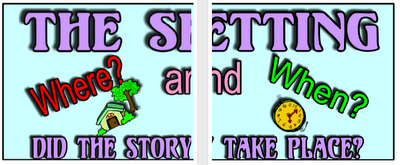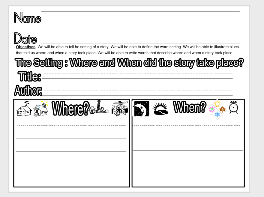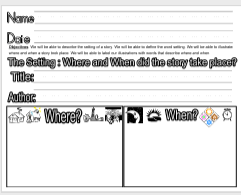Let's talk about comprehension instruction in first grade...
If you are like us, you are working on using interactive read alouds to model comprehension and think aloud strategies for your students. We are just about to start our first story element study: the setting! We start with a read aloud that depicts fall weather. Even a chapter in Henry and Mudge Under the Yellow Moon, by Cynthia Rylant can work. It doesn't have to be a long text to start. There are tons of great fall books with beautiful autumn illustrations and descriptive language to help you teach when and where a story takes place. I gather as many books as we can to keep in a bin to help with the investigative piece.
I start by reading one of my fall books aloud to the class. I start to notice the colors of the leaves, maybe there are some pumpkins or apples, or even Halloween costumes in one of our Halloween books. After the book has been read, I follow up the next day with a Reader's Workshop lesson about the setting. I start an anchor chart on my Smart Board that says "Active Readers are able to tell the Setting of a story." Underneath that I write, The setting is: Where and When! I actually do a sort of chant in a whisper for this. I snap my fingers and say..."The setting is: where and when, where and when, where and when." The students repeat and I do this several times a day while learning about the setting. (They LOVE it! They think it's funny and always enjoy trying to snap their fingers over and over!) We then return to the mentor text I read the day before. I make a t chart on the board that says where and when. I discuss what 'where' and 'when' actually mean. (I've experienced difficulty in the past with first graders discriminating between 'where and when'.) I start going back through the text looking for things that tell where and write/illustrate it on the t chart. I write and illustrate both to connect to all learners. I then begin looking for 'when' clues and do the same thing.
As part of the interactive piece during the minlesson, I have the students look through the fall bin for clues in the pictures of books. They discuss anything they find with their partners.
When they go off to read independently, they are reminded to look for clues about the setting of the story.
The next day, I repeat the process, but I look for words that tell where and when...this proves to be a bit more difficult, but I am usually able to reach a few of the learners with this activity.
The next day, we again look at our growing chart about the first mentor text. After we review, the students learn to fill out the setting paper. I let them choose whether they'd like to write the words or illustrate the clues in the boxes. I do try to suggest to some of the students to try to make sure they have a word or two that they can use to describe the clues that they found.
As we progress, I read different fall books and the students fill out the response paper. I also use the organizer with my guided reading groups of students who are reading about a level 14 (DRA). Those students higher than 20 are able to use the setting organizer as a personal response form to their independent reading or even for homework. The product differentiates itself and every first grader in my classroom is able to identify the setting of a story...whether it is from a book that has been read to them, or one they have read themselves.
In our setting pack, you get two versions of the setting organizer (one with lines for words and one without for just illustrations) and the banner that can be used to display student work. It's a great start to comprehension studies in first grade. It is also completely Common Core Related.




No comments:
Post a Comment